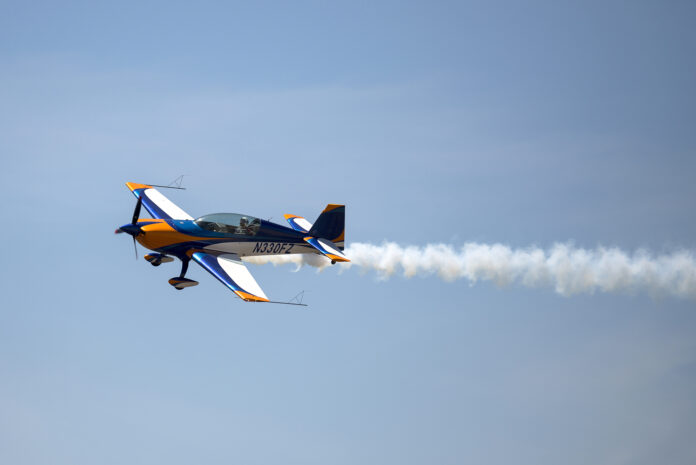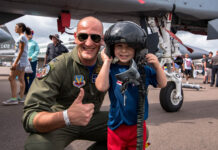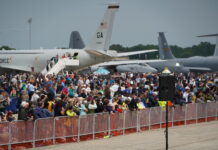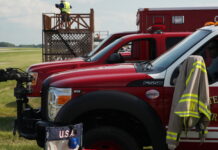
I’ve been involved with a few start-up companies and — no matter how great your idea or the measure of your financial clout — it’s always tough to gain a foothold in a new industry. Building a brand takes more than money and effort; it takes time.
I’ve come into the air show industry with a strong aerobatic competition background and pretty good name recognition from my business success in the radio-controlled airplane industry, but the same rules apply to me as anyone else. It takes years of shaking hands and meeting new people to develop the connections needed to succeed. At some point last year, I got the feeling that I had made it over the hump. I talked with ICAS President John Cudahy about this at the ICAS Convention and we felt that an article from my perspective might be helpful.
One of the things I’ve found very heartening about the air show community is that it is very accepting of newcomers. There is no escaping the fact that there are many challenges you will face in pursuit of an air show career, but I’m glad to report that they do not come from within. The community feels more like a group of people huddled together for warmth against the cold than a group in competition with each other. More than once, a fellow performer has helped me by introducing me to event organizers. I’ve felt welcomed and supported far beyond my expectations.
As a mentor of competition aerobatic pilots, I meet a lot of air show aspirants. Most of them tragically underestimate the amount of work it will take to “make it” in the air show business. Competition pilots know where they stand from a talent perspective (the scores make that clear), but they often think that is enough. They aren’t prepared for the reality that your aerobatic talent and competition resume are just one piece of a much larger puzzle. You also need showmanship, name recognition, and reputation.
Until you’ve built a strong foundation of these intangibles, you have to work from basic employment principles. What air show organizers want is the same message that a hiring manager wants to hear: “Hey, you know that thing you need done? I can do that, I’m fun to work with, I’m reliable, and I fit your budget.” Those are the four elements I need to hear from a potential employee to make a hiring decision and those are the four elements I focus on when I’m working on the next booking. It’s also the proven formula that worked for me as a consultant. Nothing changes about the principles of business engagement whether it is database systems, car sales, or air shows.
It’s easy to become too pushy, so keep in mind that how much you want something has nothing whatsoever to do with the decision making process of the person you want to give it to you. Possibly, they couldn’t care less. Pushy people get commitments that prove empty. No one opts into a conversation with someone who makes them feel uncomfortable. I’m not saying you can’t show enthusiasm. I’ve grabbed more than one person by the arm at the ICAS Convention to tell them how much I want to work for them! But, unless you address their needs from their perspective, you aren’t going to get anywhere.
Just in case it seems like I’m picking on some of my friends who are new to the air show industry, the same anti-entitlement spiel can be directed the other way. Air show organizers: I’ve been asked many times to fly shows below my cost. I’ve said ‘yes’ a few times as I’ve worked my way down to the surface level because I had no other choice. But, just as performers need to work with your needs, it’s in your best interest to reciprocate. If you book a performer at low or zero cost, there are other ways you can compensate: make sure the announcer knows how to pronounce their name; take photos and video and hand them over after the show; highlight the performer on social media; help them find their next gig; send an email of thanks and an offer to be a reference. New performers know they aren’t a hot item, but they still need to justify their time, money, and risk to be at your show and they appreciate feeling taken care of. Your show’s reputation depends on their favorable review just as much as they depend on yours. We are all in this together.
Newcomers want to know what they should charge. In the end, pricing is a matter of supply and demand. I’ve always been very curious about unintended consequences, and the air show industry has a few worth pondering.
I’m not a fan of the current system of moving performers down in altitude. There are two reasons: First, I do not think that someone’s ability to survive X number of shows at Y altitude is a good enough predictor of their ability to fly lower. Survival is just not a good minimum standard. Second, performers at 800’ are practically expected to beg for the opportunity to fly for free. This depresses the rates for all performers. You could argue it is good for the shows that they have a large pool of practically free talent to draw from, but that’s bad thinking because there is no financial incentive for the new performer to spend time developing a truly marketable skill before performing, and no way for show organizers to differentiate among new pilots. The economic concept we are missing is called “price signalling.” Given the surplus of performers trying to break in, an air show, at its worst, can become the equivalent of an open mic night.
To me, it would be better if we prohibited people from flying air shows at all until we were sure they could safely fly at an altitude that makes for an exciting show. This is how other entertainment industries operate: no one buys a ticket to the circus to watch people trying the trapeze for the first time. They want to see the performer so capable he can “work without a net.” See, there is even a saying for it!
Speaking just to air show newcomers or aspirants now: I’ve worked with many pilots to help them get better at competition and I believe you simply must have regular critique and evaluation to get better at aerobatics. This is why so many of the top air show pilots have been on the US Unlimited Aerobatic Team. You know the names: Patty Wagstaff, Kirby Chambliss, Michael Goulian, Matt Chapman, Jeff Boerboon, Rob Holland, Gene Soucy. These people practiced over and over, building deep stick and rudder skills while maintaining situational awareness. They know where the crowd line is at all times. They know how to control their aircraft and get the most out of it. We have nothing analogous to this in the air show world. I strongly recommend you build up your competition chops even if that means putting your air show dreams on hold a bit.
Please contact me and let me know how right or wrong I am on anything I’ve written here. I can be reached at jtbourke@gmail.com.







